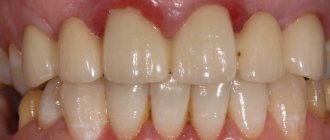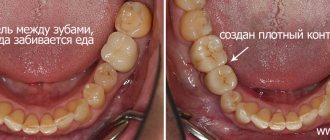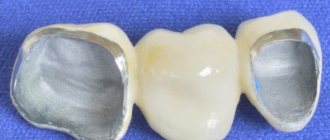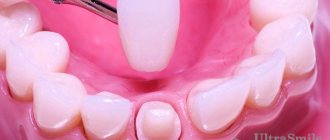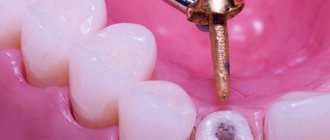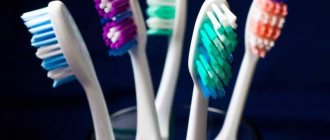- Service life of different types of crowns
- Late crown replacement
- When to change a crown
- How to change crowns
- How often are crowns replaced?
- Additional videos
Sooner or later, most people have to deal with dental prosthetics.
Perhaps the most common type of prosthetics is the so-called “dental crown” (more information about different crowns here). Many patients are their owners, but only a few patients ask questions: do dental crowns need to be replaced, how often should dental crowns be changed, etc.
Let's try to figure it out.
What is the service life of different types of crowns?
As you know, any structure has a certain service life. Unnecessarily long use can lead to dire consequences.
So: how often should crowns be replaced?
It is believed that the average service life of a crown is 5-7 years. At one time, scientists proved that it is after such a period of time that the cement on which the crown is fixed begins to undergo changes. But this does not mean that the crown must be changed every 5 or 7 years. During this period, a doctor should evaluate it to understand whether it can still serve or whether the crown needs to be replaced.
In addition to the duration of use, during a preventive examination, the doctor evaluates the following parameters: the quality of the marginal fit of the crown to the tooth, the condition of the gums and bone tissue next to the crown, X-ray data of the tooth, patient complaints, etc.
Complications after installing a permanent dental crown
Installing crowns can cause various complications and risks.
The most common complication during installation is increased sensitivity of the teeth on which the crown is installed to heat or cold.
This sensation is common, but if there is increased sensitivity when pressing on the tooth, the crown may not be installed correctly and the crown may need to be repositioned or the top portion may need to be sawed off to correct the defect.
Some types of crowns, especially porcelain ones, are vulnerable to chipping and cracking. When installing porcelain or ceramic crowns combined with metal alloys, when part of the structure is chipped, the metal base may be exposed. If there is no damage to the base, it does not need repair. However, the top porcelain part requires reconstruction.
If there is not enough dental cement when installing a crown, it may become loose and even fall out.
Sometimes there is an allergic reaction to the metal used in some crowns. In some cases, the gums begin to hurt or become inflamed, and the area begins to bleed. This could be a sign of gingivitis or gum disease.
What determines the service life of a crown?
- The service life and the need to replace the structure greatly depend on the accuracy of manufacturing at all stages. Precision work means that the crown fits to the tooth without gaps, without steps, without voids, oral fluid and food do not get under it, the gums around it do not become inflamed, it is no different from the “native” tooth. It is the precision of manufacturing that determines the quality of work, and therefore is the key to a long service life of the crown. For example, I had to deal with a situation where the crown was made only a year ago, and upon examination, strict indications for its urgent replacement were revealed (due to poor quality, namely inaccurate manufacturing). And vice versa, when examined, the crown meets all the requirements, all parameters are normal, there is no need to replace it, and it has been standing for 10 years (which means it was manufactured very accurately and in a timely manner).
- We have repeatedly mentioned that accuracy, and therefore quality, is at the forefront. If we take quality as a given, then the material and method of fixation come to the fore. So, the service life also depends on the material from which the crown is made and, accordingly, on the method of fixing it to the tooth . Classic metal-ceramics and zirconium dioxide-based crowns are attached to a special “cement,” that is, an intermediary between the crown and the tooth, and do not enter into a “chemical” bond with either this cement or the ground tooth. Namely, this cement is “destroyed” and “washed out” over time, leading to a violation of the seal of the entire structure. Crowns based on lithium disilicate (also called “E-max”) are fixed without an intermediary: using the adhesive (“glue”) method, that is, they are glued to the tooth tissue, which leads to a very strong connection between the crown and the tooth. Accordingly, the service life of such structures is longer than the 5-7 years described above, which means that a crown change will not be required soon.
- In addition, the service life is greatly influenced by the condition of the tooth for which the crown was made. If a patient hesitates for a long time to adequately restore a damaged tooth, he comes for prosthetics at an untimely rate, in particular when the tooth is destroyed by a carious process to the level or below the level of the gum, becoming “soft” and unreliable. In such conditions, the doctor is no longer able to make an accurate marginal fit; such a structure will never be completely sealed, which means the tooth under such a crown will be destroyed. In such conditions, neither good materials nor the method of fixing the crown will help. And if the doctor nevertheless undertakes the restoration of such a tooth, this will be the last crown on it, since it will be impossible to repeat the restoration.
Important! Dear patients, do not delay the restoration of damaged teeth, do not deprive yourself of the opportunity to save your own tooth faster, more reliably and cheaper!
By clicking on the “Make an appointment” button, I consent to the processing of my personal data.
I have read and agree with the conditions for processing personal data set out on the website ds-chocolate.ru.
Consent to the processing of personal data
What can be done if loss has already occurred?
If a crown falls off, it is not always possible to contact a dentist immediately. This could be an episode of emergency at work, or a business trip. Or the option is that “your”, “favorite”, etc. dentist is on vacation right now.
Considering that complete installation of the crown in place at home is technically impossible, measures should be taken to temporarily strengthen it. To regain the temporary ability to at least chew (we are not talking about a Hollywood smile here at all).
Carrying out repairs in camping and home conditions is possible with the help of:
- dental cement;
- dental glue.
The option with glue implies a faster repair, while with cement there is greater structural strength, but both of them are a temporary measure, nothing more.
We will give several general recommendations that do not depend on the choice of fixation method.
The removed prosthesis should be carefully examined, identifying its front and back surfaces. Only after this, having thoroughly washed and dried the crown and cleaned the exposed tooth-base, should you carefully and correctly put it on, carefully and slowly clench your teeth. If the adhesion to the base tooth is sufficient (the crown does not rotate or be removed), you can leave the situation unchanged for one or two days.
If the crown does not fit like a glove, you should carefully remember its correct, most comfortable position, guided by your own feelings.
The method of attaching the crown should be chosen based on the goals - glue is a faster, but less durable method of fixation, cement is a more reliable, but at the same time difficult way to achieve what you want.
What are the consequences of untimely crown replacement?
1. Destruction of the tooth under the crown with its subsequent loss.
The main function of a crown is to restore a badly damaged tooth and protect it. The first time after installation, the crown performs its function perfectly. But after a certain time, changes occur. The gingival margin rises, saliva and gingival fluid affect the cement that “secures” the crown. Over time, this cement can be partially washed out (dissolved), a microscopic gap is formed between the crown and the tooth, and the tooth begins to deteriorate under the influence of microbes and oral fluid. The most insidious thing is that these signs occur asymptomatically and unnoticed by the patient, since they are painless. Therefore, replacement of crowns often occurs untimely, when the tooth is destroyed too much and becomes simply unreliable.
Associated with this is the myth that teeth under crowns are destroyed. The truth is that crowns are simply replaced at the wrong time, but too late.
This can be prevented by timely replacement of the orthopedic structure.
2. Inflammation of the tissues around the crown . This means the gums, tooth ligament and bone tissue. A poor-quality crown can lead to the formation of a chronic inflammatory process in the gums (gingivitis, periodontitis), which is manifested by redness, bleeding when brushing teeth, aching pain in the gums and an unpleasant odor. If such a crown is not replaced for a long time, the underlying tissues become involved in the inflammatory process, which may lead to the formation of bone pockets, disruption of the ligamentous apparatus of the tooth, and local periodontitis, which in severe cases leads to tooth loss.
Photo 2.1. Inflammation of the gums near teeth under crowns, associated with inaccurate marginal fit of the crown to the tooth and with a violation of the biological parameters of tooth restoration.
Important! Make it a rule to visit the dentist for a preventive examination at least once a year, if you have any dentures, in order to notice their failure in time and prevent or correct the problem.
Procedures required for high-quality dental crown installation
The procedure for installing a dental crown is preceded by a primary diagnosis of the oral cavity and the study of all its features, identifying inflammatory processes.
At this stage, the qualifications of a specialist are especially important, as well as the use of modern equipment, in particular, tomographs, which allow one to see and assess the condition of the patient’s oral cavity, and determine the most optimal prosthetic scheme for him.
Based on the diagnostic results, possible contraindications to the procedure for installing structures are determined, as well as the necessary treatment and subsequent stages of the prosthetic operation.
How do you know if it’s time to change the crown or if it can still serve?
There are objective signs that reflect the condition of crowns/bridges, which are assessed by an orthopedic dentist during a routine examination:
- service life of the crown/prosthesis
- patient complaints (pain, food getting stuck near the crown, unpleasant odor near the crown, and others)
- fit of the crown to the tooth (marginal fit)
- the presence of areas of plaque accumulation
- condition of the gums next to the crown (color, bleeding, density, presence of other signs of inflammation, raising the edge of the gums (exposure of the root))
- presence of signs of inflammation of the bone tissue around the tooth with a crown
- density of interdental contact (crowns with adjacent teeth).
If one or a number of signs are present, the doctor decides whether the crown needs to be replaced.
What crowns are best for chewing teeth?
Single dentures for molars and premolars must first of all solve the problem of functionality and prevent further destruction of hard dental tissues. Aesthetics in this case are secondary. If you need prosthetics, the question immediately arises - which crown is best to put on a chewing tooth? Orthopedic dentistry offers single dentures from different materials:
- metal alloys, including precious ones;
- metal-plastics;
- metal ceramics;
- ceramic composites and their combinations;
- ceramics;
- zirconium dioxide;
- aluminum oxide.
The variety of materials can easily be confusing. When prosthetics of the masticatory region, high demands are placed on crowns in terms of strength and durability. To create a prosthetic structure, biocompatible materials that are resistant to high mechanical load are used.
Can the patient himself understand that it is time to replace the crown?
Certainly! There are a number of signs, the presence of which should give cause for concern.
- The most common is crown edge exposure , when the gingival margin rises and the tooth root becomes visible (“gingival recession”). In this case, root caries may develop, that is, the tooth may be destroyed.
Photo 2.2. The initial stage of exposure of the roots of the teeth under the crowns.
Photo 2.3. The advanced stage of exposure of the roots of the teeth under the crowns.
- Inflammation of the gums around the crown , which manifests itself in redness of the gums, swelling, and bleeding when brushing.
Photo 2.4. Inflammation of the gingival margin of teeth under crowns, associated with inaccurate marginal fit of the crown to the tooth and with a violation of the biological parameters of tooth restoration.
- The appearance of crown mobility . Patients often say that the crown or bridge is “fixed.” This happens especially often when several crowns are combined (some of the crowns of the bridge have become uncemented, while the rest are still holding together).
- The appearance of an unpleasant odor or taste in the crown area.
- Food getting stuck between crown/crown and tooth.
Important! All of the above signs are a mandatory reason to visit the dentist.
How are crowns replaced?
A separate article will be devoted to this. Let us briefly describe the main stages:
Stage 1 : examination by a doctor and diagnosis (X-rays). We evaluate the accuracy of the crown fit, the condition of the tooth and surrounding tissues. We understand that the crown needs to be replaced.
2nd stage : silicone key (necessary for the doctor to make you a temporary crown so that you do not go without a tooth after removing the old one)
Stage 3 : we evaluate the tooth under the crown, give it the correct shape, clean it, and remove possible caries. We fix the temporary crown. You can't go a day without a tooth!
Stage 4 : we take impressions for the new crown and send them to the dental laboratory.
Stage 5 : we get a new crown, fix it on the tooth and happily say goodbye to the doctor until the next professional examination.
WHY DO YOU NEED TEMPORARY CROWNS?
Usually, before installing a crown or prosthesis, the tooth needs to be ground, and only after grinding can impressions be taken and the manufacture of dentures begin. A ground tooth looks very unsightly and causes both aesthetic and psychological discomfort to the patient. To restore the aesthetics and functionality of the dentition, temporary, or provisional, crowns are used. They are especially relevant for the front teeth. However, plastic crowns not only mask visual defects in the dentition. They perform several more very important functions: • Temporarily restore the function of a ground tooth; • Allows you to maintain normal diction; • Do not allow infection to enter the tissues of the prepared tooth; • Prevent gum tissue from growing onto the tooth to ensure normal installation of a permanent crown; • Allow a person to quickly get used to a permanent crown; • Firmly fix the tooth and prevent it from moving to the sides or staggering; • Maintains bite, preventing neighboring teeth from taking up free space; • If a tooth is ground down without removing the nerve, it becomes very sensitive to temperature and chemical stimuli, which can cause pain. A temporary crown protects such a tooth.
Bottom line: how long does it take to replace crowns?
According to the book rules : in 5-7 years.
It is better to replace poorly made crowns immediately after placement, so that the teeth underneath do not deteriorate.
Well-made crowns can last 10 years or more.
Conclusion: any crown has a certain service life, which depends on the characteristics of the clinical situation (tooth condition), quality of workmanship, material and method of fixation. The need for replacement is determined by the doctor based on a number of objective factors. Timely replacement allows you to reuse the same foundation (tooth, root) to repeat the structure. Accordingly, the tooth will last for many years. Untimely replacement of the crown (unreasonably long use) can lead to deep tooth destruction, which will be impossible to restore.
An attentive attitude to one’s health on the part of the patient, coupled with timely and qualified assistance from a doctor, leads to a long-term positive result.
By clicking on the “Make an appointment” button, I consent to the processing of my personal data.
I have read and agree with the conditions for processing personal data set out on the website ds-chocolate.ru.
Consent to the processing of personal data
Be healthy!

